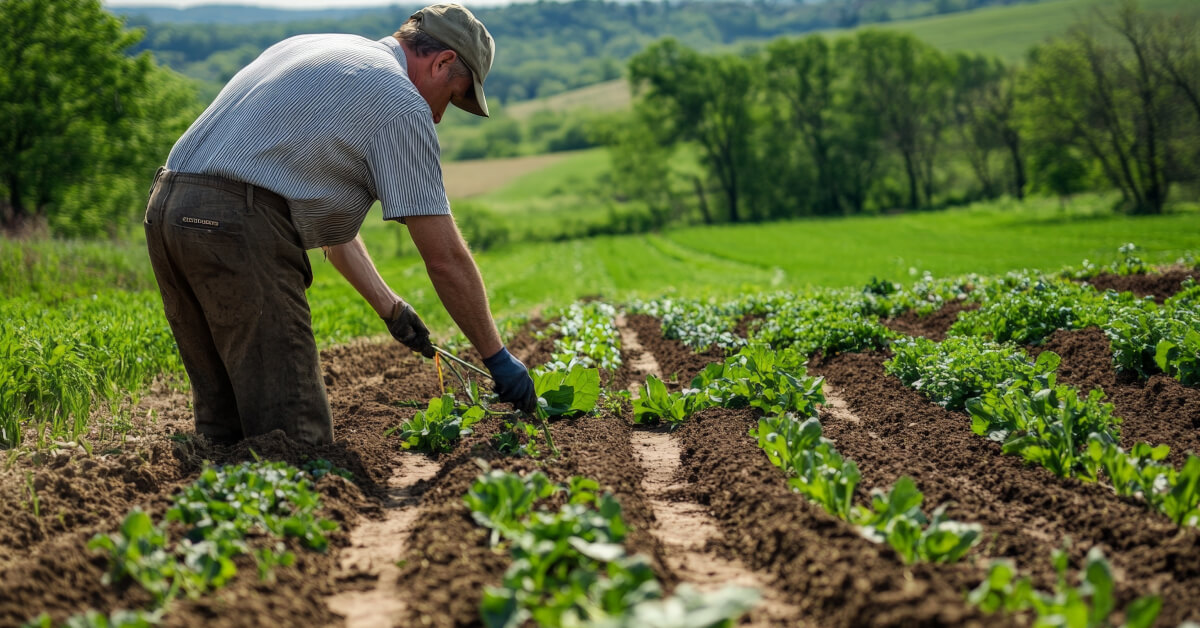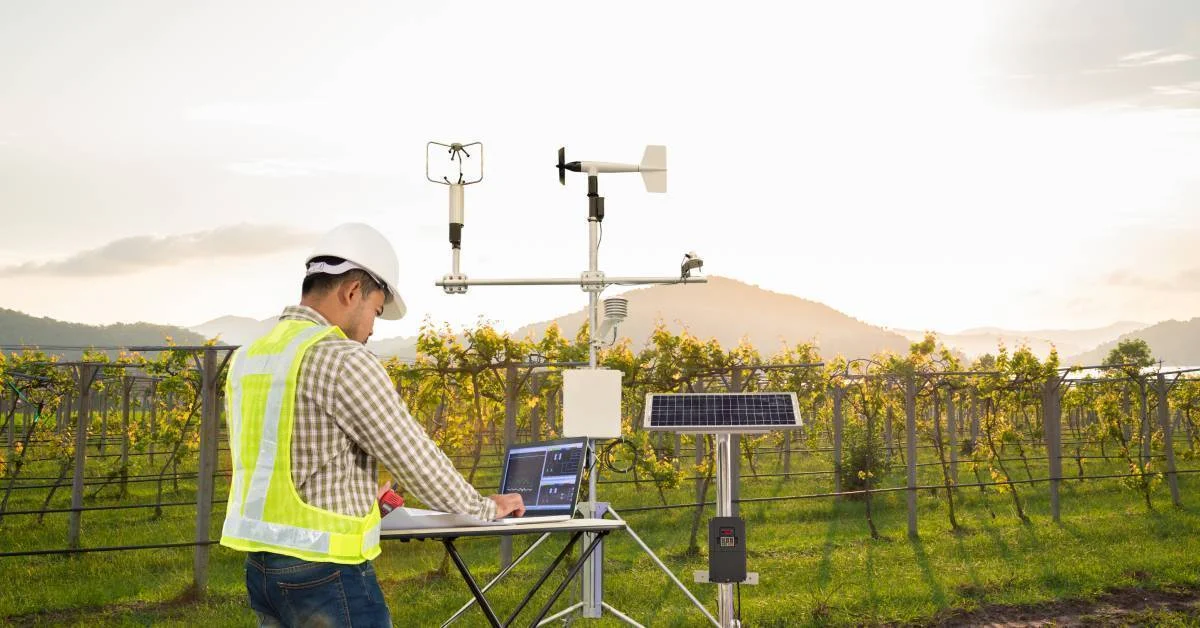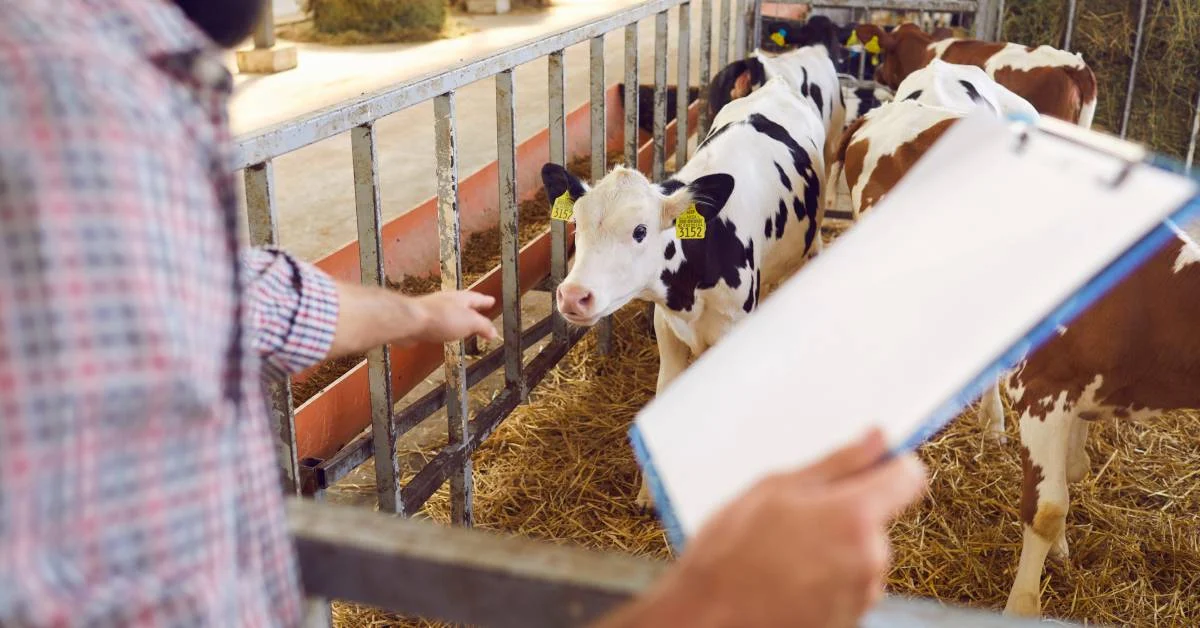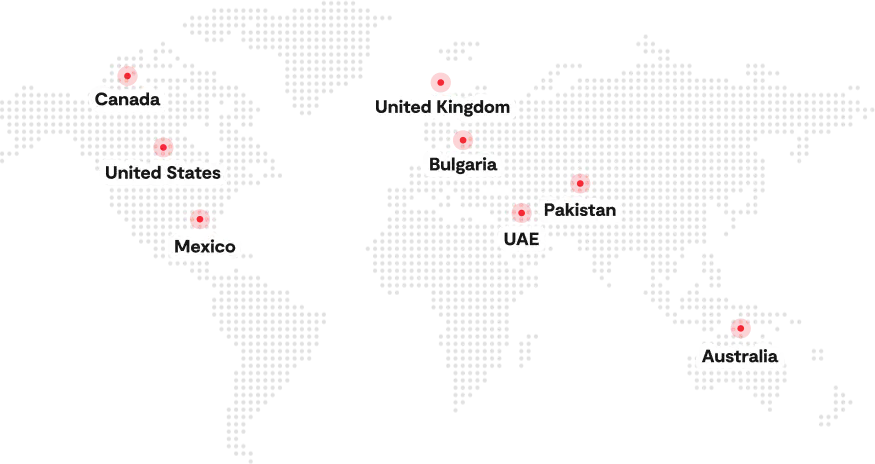Polyculture farming is a way to grow two or more compatible crops together in the same area at the same time. In plain terms, the polyculture farming definition is “planned diversity in one field,” arranged so plants share resources instead of competing.
In this guide, you’ll learn the main polyculture methods, polyculture farming examples, and the benefits of polyculture farming, along with the pros and cons you need to plan for. You’ll also get a polyculture farming diagram and a clear transition plan you can pilot on one block before scaling.
What Is Polyculture Farming?
Polyculture farming is the planned, simultaneous cultivation of two or more compatible crop species (or varieties) in the same field or land unit. In plain language, the polyculture farming definition is “multiple crops, one space, one season,” designed to work together. You might pair a cash crop with a legume and a groundcover. Aim for complementary roots and canopies. The key point: same acre, same time, this is not crop rotation.
What a Polyculture Farming System Looks Like
On the ground, a polyculture farming system looks like intentional “stacking”: crops arranged so each one plays a role, with planned spacing and timing. That can be simple (strip intercropping as corn beside soy) or more layered. In multi-layer systems, you might have groundcover under a shrub layer with trees above, so roots and canopy occupy different zones and reduce bare soil.
Polyculture vs. Crop Rotation vs. Mixed Farming
Polyculture means multiple species growing together at the same time on the same land unit. Crop rotation is different crops in sequence on the same field across seasons. Mixed farming refers to combining crops and livestock on one farm; it may use monocultures or polycultures, depending on the design.
Monoculture vs Polyculture Farming (The Practical Comparison)
Use this polyculture vs monoculture farming table to choose what fits your operation.
| Dimension | Monoculture | Polyculture | “What it mean for your farm” |
| Operations | Single crop, uniform timing | Multiple crops, coordinated timing | More planning, fewer “all-eggs” risks |
| Inputs | Often higher external inputs | More biological functions | Potential savings, manage competition |
| Pest/Disease Risk | Host concentration favors outbreaks | Diversity can slow spread | Scouting shifts toward thresholds |
| Yield Stability | High upside, high downside | Often steadier across shocks | More predictable year-to-year |
| Soil Health | Simplified residues, lower diversity | Diverse roots, residues, cover | Better structure if managed well |
| Mechanization | Simplest planting/harvest | Needs equipment-fit layouts | Start with strip widths your gear handles |
| Market Flexibility | One buyer spec to hit | Multiple products/outlets | More marketing work, more options |
When Monoculture Still Makes Sense
Monoculture still earns its place when you run highly mechanized, single-commodity acres and your buyer demands uniform maturity, size, and quality (think processor contracts). Uniform stands let you plant, protect, and harvest in one pass with predictable logistics.
If you want the resilience of monoculture vs polyculture farming without breaking your system, hybridize: keep the cash crop in monoculture, then add a polyculture cover-crop strip, field edge habitat, or a legume intercrop pilot on one block and track costs, pressure, and yield stability.
Why Polyculture Works (The Science Without the PhD)
Learn how crop diversity improves resource use, reduces pressure, and builds resilient farming systems without complex science.
Niche Complementarity + Resource Sharing (60 words)
Polycultures work because plants “specialize.” One crop reaches deep moisture, another feeds from the topsoil, and a third shades the ground. Different canopy heights and growth timing also spread sunlight capture through the season. In well-designed intercropping, that niche complementarity can raise overall resource-use efficiency on the same acre, instead of forcing direct competition. You get more function per acre.
Pest, Disease, and Weed Dynamics
Diversity also changes pest behavior. When a field is one continuous host, insects and diseases can move fast. Mixed stands and strips add physical and chemical “noise,” making it harder for pests to locate crops and easier for natural enemies to persist. Practical result: fewer outbreak-style surprises during the season.
Soil Biology + Nutrient Cycling
Belowground, polycultures feed soil life with a wider mix of roots and residues. Legumes matter because they fix atmospheric nitrogen through symbiosis, supporting companion crops when managed correctly. Diverse cover-crop mixtures can also improve soil nutrients and microbial biomass, which helps nutrient cycling and structure over time in your fields.
Practical Polyculture Farming Methods
Explore practical polyculture farming methods you can apply using existing equipment, layouts, and manageable crop combinations.

Intercropping
Intercropping is the most common entry point in a polyculture farming system because you can test it on one block without redesigning the whole farm. Use these patterns:
Row intercropping: two crops in alternating rows.
Strip intercropping: crops in wider strips you can manage separately.
Mixed intercropping: crops grown together without distinct rows.
Relay intercropping: seed the second crop into a standing first crop before harvest.
Best when your equipment can stay efficient: strip widths match your planter and sprayer, and your harvest is compatible (same pass, or separation in the combine, cart, or storage). Start with one primary crop plus one “support” crop to keep scouting and recordkeeping manageable.
Companion Planting
Companion planting is where you place plants to influence pests and beneficial insects, not “mix for mixing’s sake.” Practical options include insectary borders that provide nectar for predators and parasitoids, trap crops that draw pests away from crops, and habitat strips that give beneficials shelter between sprays or harvests. Keep placement deliberate: field edges, headlands, or every strip block.
Diverse Cover Crop Mixes + Living Mulches
Diverse cover crop mixes and living mulches often beat single-species covers because each plant contributes a different job. Legumes can fix nitrogen through symbiosis with soil bacteria, while grasses scavenge nutrients and build fibrous roots that protect soil structure. Combined, you get broader function coverage: faster ground cover, residue that shields soil, improved nutrient capture, and weed suppression. That keeps a polyculture farming system productive between cash-crop seasons.
Agroforestry / Multi-Strata Polycultures
Agroforestry (multi-strata polycultures) integrates trees or shrubs with crops, creating layers that share light, water, and shelter. Alley cropping plants rows of trees to form “alleys” where crops grow in between. Windbreaks use tree lines to reduce wind speed and protect soil and crops. Shade systems add a canopy over crops to moderate heat and moisture loss. Perennial structure improves resilience by stabilizing microclimates and keeping living roots in place for years, but it requires planning horizons and maintenance.
Silvopasture + Crop–Livestock Integration
Silvopasture integrates trees with forage and grazing on the same land. It is ideal when you want shade and wind shelter, plus a second income stream beyond livestock. Organize paddocks as seasonal rotation blocks: graze, rest, then move, so pasture and trees recover. Benefits include cooler summer conditions for animals during heat waves and diversified products from wood and forage. Watchouts: protect young trees from browsing and rubbing, manage stocking rates to avoid soil damage, and distribute water to prevent “camping” areas.
How to Design a Polyculture Farming System (Step-by-Step)
Follow a clear, step-by-step framework to design a polyculture farming system that fits your land, labor, and markets.
Step 1 — Define Goals + Constraints
Start by being clear about why you want a polyculture farming system. Are you targeting profit stability, rebuilding soil, reducing fertilizer and pesticide inputs, increasing biodiversity, or adding grazing value? Then list hard constraints: available equipment, labor peaks, irrigation layout, and your market outlet. These realities shape what will actually work on your farm.
Step 2 — Choose Crops That “Fit Together”
Good polycultures are designed, not random. Use a simple species-pairing matrix to avoid hidden competition and surface risks early.
| Example | Rooting Zone | Nutrient Role | Canopy Timing | Harvest Compatibility |
| Crop A / Crop B | Shallow / Deep | Fixer / Scavenger | Early / Late | Same / Separate |
This approach helps you weigh the pros and cons of polyculture farming before the seed goes in the ground.
Step 3 — Layouts + Polyculture Farming Diagram
Layout is where theory meets steel and tires. Use simple, repeatable patterns you can explain to your crew and run with your equipment. Your polyculture farming diagram should clearly show one of four layouts:
Row intercropping: alternating rows of two crops.
Strip intercropping: wider strips sized to planters and harvesters.
Relay intercropping: overlap crops in time, not space.
Multi-strata systems: trees above shrubs and groundcover below.
Step 4 — Management Plan (Planting → Fertility → Irrigation → Scouting)
Management keeps a polyculture farming system from drifting into chaos. Plant to avoid one crop shading or smothering the other. Apply fertility carefully—don’t overfeed the “bully” crop. Adjust irrigation zones where rooting depths differ. Increase scouting frequency and set thresholds, because pressure patterns differ from monoculture fields.
Step 5 — Harvest + Separation + Marketing Plan
Before planting, decide how you will harvest, separate, store, and sell multiple outputs. Will crops be harvested together or separately? Do buyers exist for each product? Clear answers here turn diversity into revenue, not logistical stress.
10 Polyculture Farming Examples Across Farm Types
These polyculture farming examples are proven patterns farmers reuse because they balance biology with day-to-day operations:
- Three Sisters (corn, beans, squash): Corn provides structure, beans fix nitrogen, and squash shades soil and suppresses weeds.
- Orchard or vineyard + sheep grazing: Sheep manage weeds and residues while adding grazing revenue between rows.
- Shade coffee systems: Coffee grown under tree canopies improves microclimate and supports biodiversity.
- Dehesa-style grazing with oaks: A classic silvopasture model combining trees, forage, and livestock.
- Vegetable strips + insectary borders: Strips of vegetables paired with flowering borders that support beneficial insects.
- Grain + legume strip intercrop: Cereals paired with legumes to improve nitrogen use efficiency.
- Rice–fish systems: Fish cycle nutrients and help manage pests in flooded rice fields.
- Cover crop mixes under cash crops: Living roots protect soil between harvests.
- Windbreak trees with annual crops: Trees reduce wind stress and erosion.
- Pasture mixes (grasses + legumes): Improves forage quality and seasonal resilience.
These systems are widely documented in FAO and research-backed farming guides.
How to Pick the Right Example for Your Operation
Choose examples that fit your climate, irrigation setup, equipment width, labor availability, market access, and risk tolerance. Start with the simplest match to your existing system, often strip intercropping or grazing integration before moving into more complex layers. The best example is the one you can manage consistently, not the most diverse on paper.
Benefits of Polyculture Farming
Discover measurable benefits of polyculture farming, from stable yields and healthier soils to reduced risk and input dependency.
Better Total Output per Acre (Without Overpromising)
One of the key benefits of polyculture farming is higher system yield, the combined output of all crops on the same acre rather than chasing maximum yield from one crop. You may harvest less of a single crop, but more total usable production. Current research efforts are actively mapping and synthesizing this evidence to better quantify yield stability and productivity across systems (see Coventry University’s synthesis work).
https://pure.coventry.ac.uk/en/publications
Lower Input Dependency + Risk Spreading
Polyculture systems can reduce dependency on external inputs by spreading risk across crops. Legumes support nitrogen needs, mixed canopies improve water-use efficiency, and diversified systems can lower pesticide reliance by reducing pest pressure. For you, this means fewer “all-or-nothing” input decisions and more resilience when weather or prices shift unexpectedly.
Soil Health + Water Holding
Improved soil function is a core polyculture farming environmental impact. Diverse roots penetrate soil at multiple depths, while varied residues protect the surface from erosion. Continuous ground cover improves infiltration and water-holding capacity, helping soils handle heavy rain and dry spells better. Over time, this supports aggregation, organic matter retention, and a more resilient field structure that you can measure.
Natural Pest Suppression + Pollination Support
Diversity creates habitat. Flowering plants, varied canopy structure, and undisturbed refuge areas support beneficial insects and pollinators. This habitat logic reduces the chance of pest outbreaks spreading rapidly across a uniform field. For you, that often translates into steadier pressure levels rather than surprise infestations requiring emergency interventions.
Revenue Diversification + More Stable Seasons
Another practical polyculture farming benefit is diversified income. Multiple crops, forage, or livestock products reduce exposure to single-market price swings. If one product underperforms, others can carry part of the season. It spreads financial risk and supports more predictable cash flow across variable growing years.
Disadvantages of Polyculture Farming and How to Mitigate Them
Being clear about the pros and cons of polyculture farming helps you design systems that work in the real world, not just on paper. These are the most common polyculture farming disadvantages and how experienced operators manage them.
Management Complexity + Labor Peaks
Managing multiple crops means more decisions, tighter timing, and heavier planning, especially during planting and harvest. Labor peaks can overlap if maturity windows clash.
Mitigation: Start simple. Limit species count, align crop maturity where possible, and document standard operating procedures (SOPs) for planting, scouting, and harvest. Clear routines reduce decision fatigue and crew confusion as diversity increases.
Mechanization and Harvest Complexity
Equipment is often designed for uniform stands, not mixed fields. Poor layout can slow planting, spraying, or harvesting and increase losses.
Mitigation: Design polycultures around your machinery. Use strip widths that match planter and header sizes, and plan staged harvests where crops mature at different times. Layout first, diversity second, as it keeps field efficiency intact.
Market + Storage Logistics
More crops mean more buyers, grading standards, and storage needs. Without a plan, diversity can turn into bottlenecks.
Mitigation: Pre-sell where possible, combine CSA and wholesale outlets, and confirm storage capacity before planting to avoid forced sales at low prices.
Agronomic Risks
Poorly matched crops can compete for water, light, or nutrients, reducing overall performance.
Mitigation: Use proper spacing, balance fertility so one crop doesn’t dominate, and zone irrigation by rooting depth. Always trial new combinations on small blocks first measured, learning beats costly full-field mistakes.
Polyculture Farming Environmental Impact
Understand the environmental impact of polyculture farming using evidence-based insights on biodiversity, soil, and climate resilience.
Biodiversity Outcomes
One of the most documented polyculture farming environmental impact outcomes is improved on-farm biodiversity. Research comparing smallholder oil palm systems found that polyculture plots supported significantly higher bird species richness than monoculture plantations. The added crop diversity created varied habitat structure and food sources, benefiting wildlife without removing productive land. For you, It shows that diversification can enhance ecological value while keeping farms economically active.
Climate + Carbon + Microclimate Effects
Polyculture systems that include perennials, continuous groundcover, or multi-layer canopies reduce bare soil exposure. It lowers erosion, buffers temperature extremes, and supports carbon retention in soils and biomass. While outcomes vary by design, evidence consistently links diverse plant cover with improved microclimate stability and reduced soil loss.
How to Measure Environmental Impact on Your Farm
Track impact with practical, field-level KPIs:
- Ground cover (%) during non-growing periods
- Soil organic matter trend from repeat soil tests
- Pesticide applications per season
- Water infiltration rate after rainfall
- Habitat strips count like field edges, borders, buffers)
How to Start Polyculture Farming (1-Season Pilot Plan)
Learn how to start polyculture farming with a low-risk, one-season pilot that fits seamlessly into your existing operation.
A Simple Pilot Roadmap
Start your polyculture farming system with one field or management block. Establish a baseline first: crop yield, input costs, and a soil test. Then run a strip-based trial rather than full-field mixing. Strip intercropping lets you compare results side by side while staying compatible with existing equipment and harvest workflows.
Checklist (Seed, Equipment, Records, Scouting)
Before planting, confirm the basics:
- Equipment compatibility: planter, sprayer, harvester widths
- Planting plan: timing, spacing, and sequence
- Harvest plan: combined or staged harvest
- Storage plan: segregation and capacity
- Recordkeeping: inputs, yields, observations
5 Mistakes to Avoid
Avoid common early missteps:
- Too many species too fast
- No harvest plan
- No defined market
- Poor crop pairing
- No metrics to evaluate success
Conclusion
Polyculture farming isn’t about adding complexity; it’s about designing smarter systems that work with nature instead of against it. By combining the right crops, layouts, and management practices, you can improve resilience, stabilize yields, and reduce long-term risk. Start small, measure what matters, and refine as you go. When designed intentionally, polyculture becomes a practical, scalable path toward more productive and sustainable farming.
FAQs
What Is Polyculture Fish Farming?
Polyculture fish farming involves growing two or more compatible fish species together in the same pond or water body. Each species uses a different part of the ecosystem, such as surface, mid-water, or bottom feeding which helps improve resource use, maintain water quality, and increase overall fish production without adding extra space.
What Is The Best Polyculture Farming System For Beginners?
For beginners, the most practical polyculture farming system is a simple intercropping setup. Time-tested combinations like the “Three Sisters” (corn, beans, squash) work well because the crops support each other naturally. Mixing fast-growing greens with slower vegetables is another low-risk way to start without changing existing row layouts.
Monoculture Vs Polyculture Farming: Which Is More Profitable?
Monoculture can deliver higher short-term profits due to streamlined operations and mechanization. However, polyculture often proves more profitable over the long run by spreading risk, lowering input dependence, improving soil health, and maintaining steadier yields—especially in variable weather and market conditions.
Where Should I Place A Polyculture Farming Diagram In My Plan?
A polyculture farming diagram fits best in the Production Plan section of your farm plan. This is where you visually document how crops or species are arranged, showing layouts, spacing, and interactions so your team can clearly follow the system during planting and management.
FAQs
What Are The Benefits Of Polyculture?
Polyculture enhances biodiversity, improves soil health, reduces pest outbreaks, and increases farm resilience against climate change and market fluctuations.
What Is An Example Of A Polyculture?
An example of polyculture is the “Three Sisters” system, where corn, beans, and squash are grown together to support each other’s growth and improve soil fertility.
What Is The Difference Between Monoculture And Polyculture?
Monoculture involves growing a single crop on a large scale, whereas polyculture cultivates multiple crops together, mimicking natural ecosystems for improved resilience and sustainability.
What Crops Are Needed For Polyculture?
Polyculture systems typically utilize a mix of complementary crops, such as grains, legumes, vegetables, and herbs, selected for their ability to support one another’s growth and enhance soil fertility.







